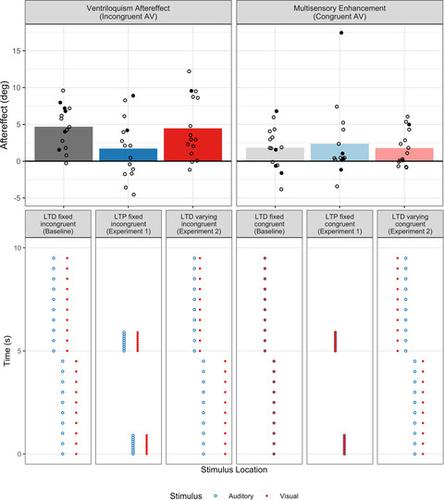当前位置:
X-MOL 学术
›
Eur. J. Neurosci.
›
论文详情
Our official English website, www.x-mol.net, welcomes your
feedback! (Note: you will need to create a separate account there.)
Differential effects of the temporal and spatial distribution of audiovisual stimuli on cross-modal spatial recalibration.
European Journal of Neuroscience ( IF 2.7 ) Pub Date : 2020-05-13 , DOI: 10.1111/ejn.14779 Patrick Bruns 1 , Hubert R Dinse 2 , Brigitte Röder 1
European Journal of Neuroscience ( IF 2.7 ) Pub Date : 2020-05-13 , DOI: 10.1111/ejn.14779 Patrick Bruns 1 , Hubert R Dinse 2 , Brigitte Röder 1
Affiliation

|
Visual input constantly recalibrates auditory spatial representations. Exposure to isochronous audiovisual stimuli with a fixed spatial disparity typically results in a subsequent auditory localization bias (ventriloquism aftereffect, VAE), whereas exposure to spatially congruent audiovisual stimuli improves subsequent auditory localization (multisensory enhancement, ME). Here we tested whether cross-modal recalibration is affected by the stimulation rate and/or the distribution of audiovisual spatial disparities during training. Auditory localization was tested before and after participants were exposed either to audiovisual stimuli with a constant spatial disparity of 13.5° (VAE) or to spatially congruent audiovisual stimulation (ME). In a between-subjects design, audiovisual stimuli were presented either at a low frequency of 2 Hz, as used in previous studies of VAE and ME, or intermittently at a high frequency of 10 Hz, which mimics long-term potentiation (LTP) protocols and which was found superior in eliciting unisensory perceptual learning. Compared to low-frequency stimulation, VAE was reduced after high-frequency stimulation, whereas ME occurred regardless of the stimulation protocol. In two additional groups, we manipulated the spatial distribution of audiovisual stimuli in the low-frequency condition. Stimuli were presented with varying audiovisual disparities centered around 13.5° (VAE) or 0° (ME). Both VAE and ME were equally strong compared to a fixed spatial relationship of 13.5° or 0°, respectively. Taken together, our results suggest (a) that VAE and ME represent partly dissociable forms of learning and (b) that auditory representations adjust to the overall stimulus statistics rather than to a specific audiovisual spatial relationship.
中文翻译:

视听刺激的时空分布对跨模式空间重新校准的不同影响。
视觉输入不断地重新校准听觉空间表示。暴露于具有固定空间差异的同步视听刺激通常会导致随后的听觉定位偏差(听觉后遗症,VAE),而暴露于空间一致的视听刺激会改善随后的听觉定位(多感觉增强,ME)。在这里,我们测试了交叉模态重新校准是否受训练期间的刺激率和/或视听空间差异的分布影响。在参与者暴露于恒定视差13.5°(VAE)的视听刺激或空间一致的视听刺激(ME)之前和之后,对听觉定位进行了测试。在受试者之间的设计中,视听刺激以2 Hz的低频呈现,在以前的VAE和ME研究中使用,或者间歇性地在10 Hz的高频下使用,它模仿了长期增强(LTP)协议,并且在引发单感性知觉学习方面更胜一筹。与低频刺激相比,高频刺激后VAE降低,而无论刺激方案如何,均发生ME。在另外两个组中,我们在低频条件下操纵了视听刺激的空间分布。呈现的刺激具有围绕13.5°(VAE)或0°(ME)的变化的视听差异。与固定的空间关系13.5°或0°相比,VAE和ME均具有同等的强度。在一起
更新日期:2020-05-13
中文翻译:

视听刺激的时空分布对跨模式空间重新校准的不同影响。
视觉输入不断地重新校准听觉空间表示。暴露于具有固定空间差异的同步视听刺激通常会导致随后的听觉定位偏差(听觉后遗症,VAE),而暴露于空间一致的视听刺激会改善随后的听觉定位(多感觉增强,ME)。在这里,我们测试了交叉模态重新校准是否受训练期间的刺激率和/或视听空间差异的分布影响。在参与者暴露于恒定视差13.5°(VAE)的视听刺激或空间一致的视听刺激(ME)之前和之后,对听觉定位进行了测试。在受试者之间的设计中,视听刺激以2 Hz的低频呈现,在以前的VAE和ME研究中使用,或者间歇性地在10 Hz的高频下使用,它模仿了长期增强(LTP)协议,并且在引发单感性知觉学习方面更胜一筹。与低频刺激相比,高频刺激后VAE降低,而无论刺激方案如何,均发生ME。在另外两个组中,我们在低频条件下操纵了视听刺激的空间分布。呈现的刺激具有围绕13.5°(VAE)或0°(ME)的变化的视听差异。与固定的空间关系13.5°或0°相比,VAE和ME均具有同等的强度。在一起











































 京公网安备 11010802027423号
京公网安备 11010802027423号